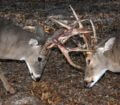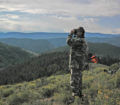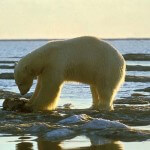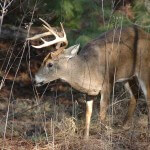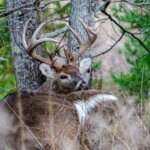Editor’s Note: These scientific facts about America’s favorite game animal – the white-tailed deer – are interesting and can help you fill your tag.
 * The white-tailed deer had dropped from a high of 50-million animals to almost extinction in the late 1880s. But help and protection from conservationists has brought the numbers of white-tailed deer to about 14 million today.
* The white-tailed deer had dropped from a high of 50-million animals to almost extinction in the late 1880s. But help and protection from conservationists has brought the numbers of white-tailed deer to about 14 million today.
* A doe’s milk contains twice the solids and three times the fat and protein of a Jersey milk cow’s, which means a fawn quadruples its weight in a month.
* A doe licks its newborn fawn completely with her tongue and even may eat the placenta before leading the newborn away from the birthplace – all to protect the fawn from predators.
* Coyotes quickly pick up the scent of an adult deer long after it’s passed by a place due to its interdigital gland secretions between the deer’s hooves, but a fawn doesn’t produce these secretions.
* A scrape always is accompanied by a low, overhanging tree branch that is chewed and broken by the buck that has made the scrape. The buck deposits saliva and forehead gland scent on the branch to pass along olfactory information to other bucks and does in the region that this is his chosen breeding area.
 * Hunters commonly find a pair of shed antlers in the immediate vicinity of each other – not because they naturally dropped at the same time. Rather, when one antler falls, the imbalance that is created by the remaining antler annoys the deer. He then kicks at it with a hind foot, or knocks it against tree trunks, to dislodge it as well.
* Hunters commonly find a pair of shed antlers in the immediate vicinity of each other – not because they naturally dropped at the same time. Rather, when one antler falls, the imbalance that is created by the remaining antler annoys the deer. He then kicks at it with a hind foot, or knocks it against tree trunks, to dislodge it as well.
* Whitetails are relatively immune to bitter-cold weather. The species lives as far north as the 59th parallel (which cuts across northern Manitoba and Saskatchewan) where the winter-air temperature commonly plummets to minus-60 degrees Fahrenheit.
* Unknowledgeable hunters often mistakenly refer to deer antlers as “horns.” Horns remain with an animal for its entire life, but antlers, like those of deer, are shed every year.
* Whitetails have in the roofs of their mouths a vomeronasal organ that allows them to “taste” odors their noses detect. After this chemical analysis is performed, the information is instantly transmitted to the brain to elicit a reaction.
 * The smallest whitetail inhabiting North America is the Key deer, a protected and endangered species that lives exclusively in southernmost Florida, primarily on 20-25 islands in the Florida Keys. A mature adult stands only 22-inches tall and weighs 45 to 65 pounds, about half the size of a Labrador retriever.
* The smallest whitetail inhabiting North America is the Key deer, a protected and endangered species that lives exclusively in southernmost Florida, primarily on 20-25 islands in the Florida Keys. A mature adult stands only 22-inches tall and weighs 45 to 65 pounds, about half the size of a Labrador retriever.
* The deer rack with the most points ever was a 333-7/8 point deer rack, picked up by a hunter in Missouri.
* Radio-telemetry research has revealed that, across a whitetail buck’s home range, it lays down its scrapes in a “star” configuration with one scrape line having a north/south axis that intersects with a second scrape line having an east/west axis.
* Bucks often share so-called “community scrapes” that may be revisited and anointed with scent by as many as three or four different males. But the behavior is almost solely engaged in by immature males less than 3-1/2-years old.
* A doe entering estrus just prior to breeding chases away her buck and doe yearling fawns. After breeding, the doe fawn is permitted to rejoin her. But the young buck travels far to adopt a new home range elsewhere, which is nature’s way of preventing inbreeding among family members following fall.
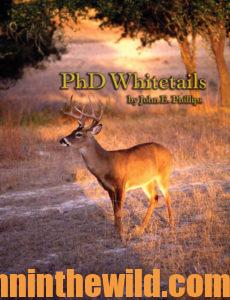 To learn more about hunting deer, see John E. Phillips’ book, “PhD Whitetails: How to Hunt and Take the Smartest Deer on Any Property,” available in Kindle, at https://www.amazon.com/dp/B007A2N792.
To learn more about hunting deer, see John E. Phillips’ book, “PhD Whitetails: How to Hunt and Take the Smartest Deer on Any Property,” available in Kindle, at https://www.amazon.com/dp/B007A2N792.
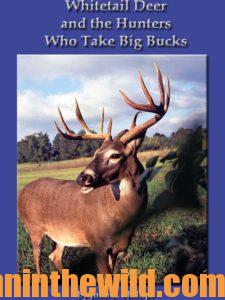 Check-out too John E. Phillips’ book, “Whitetail Deer and the Hunters Who Take Big Bucks,” available in Kindle and paperback, at https://www.amazon.com/Whitetail-Deer-Hunters-Take-Bucks-ebook/dp/B01KU0O1KY.
Check-out too John E. Phillips’ book, “Whitetail Deer and the Hunters Who Take Big Bucks,” available in Kindle and paperback, at https://www.amazon.com/Whitetail-Deer-Hunters-Take-Bucks-ebook/dp/B01KU0O1KY.

